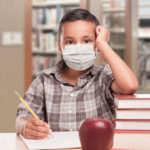Back to school during COVID-19: Children with special needs

If this were a normal year, summer would be wrapping up and kids would be returning to the routines of another school year. But school will be different this fall. From staggered start times to classrooms set up for physical distance, kids are in for an unpredictable year. The many changes may be especially difficult for kids with special needs.
Many school districts have spent the summer developing pandemic safety plans and will continue refining details this fall. How can parents prepare their kids with special needs for so many unknowns?
Keep it simple and focus on safety
“It’s going to be impossible to prepare kids for every single thing that’s going to be different at school,” says Dr. Nicole Baumer, director of the Down Syndrome Program and physician in the Autism Spectrum Center. She suggests parents focus on the three most important rules kids will have to follow at school: physical distancing, wearing masks, and frequent hand washing. “The more parents practice these things with their kids at home, the better.”
Make masks normal
Wearing a mask takes some getting used to, but will be expected at school. You might set aside time each day for your child to practice wearing a mask. If they can only tolerate the mask for short periods, slowly increase the time they wear it each day. More tips to help children wear a mask
Kristin Coffey, child life specialist with the Autism Spectrum Center, suggests letting kids pick the color or pattern for their masks. “Whether they choose a print or a cartoon theme, picking out their mask can give kids a sense of ownership when there are so few things they can control.”
Keep things positive
Given all of the restrictions necessary to prevent COVID-19 infection, it’s easy to focus on things that will be off limits at school. “Rather than over-stressing what your child can’t do, use positive language to tell them what they can do,” advises Dr. Cara Soccorso, attending psychologist in the Developmental Medicine Center and Down Syndrome Program. Instead of telling your child they can’t hug their friends, for instance, suggest alternative greetings, such as air hugging, clapping, or jumping up and down.
Be honest about change
In this year like no other, parents will need to hit the right balance between being upbeat while not painting an overly rosy picture of the school year. “Parents shouldn’t make promises they can’t follow through on,” cautions Coffey. For instance, you might want to reassure your child you’ll let them know well in advance if their school is going to go fully remote. But you might not have that ability. Instead, give your kids concrete information in small amounts. “Be honest about the fact that this is how things are being done for now. Things might change, and if they do, you’ll talk about it with them.”
Color-code your calendar
Shifting between in-person and remote learning won’t be easy for many children with special needs on a hybrid learning schedule. Children who rely on routine could be unsettled by the fact that their Tuesdays are completely different from their Wednesdays, for example. And while no one knows for sure what will happen, rising infection rates could force some schools to close this fall.
Rather than overloading kids with uncertainty, Dr. Baumer suggests color- coding a calendar. Mark at-school days green and at-home days blue, for instance. Depending on what happens at your child’s school, a week or month may change to all blue. “A visual tool like this can help your child understand that things might shift.”
Your child’s individualized education plan and COVID-19
Unfortunately, in the six months since schools shut down, many kids with individualized education plans (IEPs) lost some of the skills they’d previously gained. “Many of our patients have developed emotional or behavioral needs they didn’t have in the spring,” says Dr. Soccorso.
On the bright side, many families used the time at home to work on adaptive life skills like grooming and getting dressed. Nonetheless, it’s essential for educators to know how their students’ educational needs have changed. “We strongly encourage parents to get in touch with their school districts to talk about how their child’s IEP may need to be adjusted this year.”
Managing emotions during a difficult school year
No matter how well you prepare your kids for change, they may still struggle, especially at first. “Maintaining consistent routines at home will be more important than ever,” says Dr. Baumer. Knowing they can return to a predictable home setting each day can help ease the anxieties of this unpredictable year.
You might also plan special family events. Given how many things have been cancelled, Coffey suggests turning things you used to take for granted into special occasions. “Pizza night on Friday or going for a weekend walk can become something the family looks forward to.”
Get more answers about COVID-19 and learn about the Down Syndrome Program, Autism Spectrum Center, and Developmental Medicine Center.
Related Posts :
-

Preparing your kids for the new school year during COVID-19
This back-to-school season is shaping up to be unlike any before. As kids, parents, teachers, and schools approach the start ...
-

Back to school and COVID-19: Tips for divorced parents
Fall 2020 will go down in history as one of the most complicated back-to-school seasons ever. The uncertainties of the academic ...
-

Tips for getting through the rest of this school year — and possibly next
If you’re like most parents, you’re not trained to be a teacher or a tutor. And yet, many ...
-

COVID-19 and IEPs: Education for children with special needs
When Massachusetts shut down its public schools to prevent the spread of COVID-19, educators faced a huge challenge. With little ...





